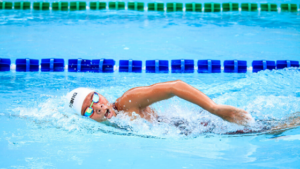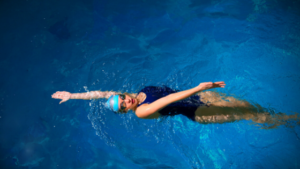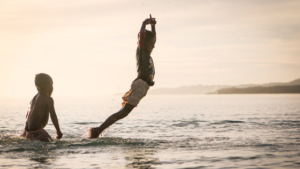Swimming – the only sport where you can get told off for breathing too much!
When you are training, no matter what sport or discipline, it’s very important to stay interested. A great way of staying interested and keeping your motivation to push yourself is to see improvement. I hope that this article will give you some hints and tips to spice up your stroke. With any sport repetition sometimes becomes boring so it’s always beneficial to mix up your sets and try new drills. Whether you are a competitive swimmer or an expert at Doggy Paddle, hopefully, you will come away with something you can work on the next time you go in for a dip. There are some very simple adjustments you can make when swimming to massively improve your stroke. No matter what stroke you are swimming it is very important to stay as streamline, that is as flat as possible in the water. You want to maintain this position so that you are creating minimal drag and as little resistance as possible in the water. To ensure you squeeze the most out of your time in the pool have a look at some of these technique tips, one stroke at a time.

Front Crawl
A streamline position on your front is achieved by stretching your arms above your head and squeezing your ears with your arms while keeping your shoulders relaxed. Tuck your chin down into your chest, engage your core and keep your legs long and straight with toes pointed. Practicing a push and glide off the wall is a great way to get used to this position. Every length of front crawl you swim, be it from a dive or pushing off the wall, you should always start in a streamline position. When swimming, try and keep your eyes forward and down, so that your head is in line with your body and the water level is at the same point as your hairline. Aim to keep your head still, only moving it when you need to take a breath.
Rotate your hips and shoulders as you move through the water to generate momentum. Let your shoulders rotate more than your hips and try bringing your elbow out of the water as high as you can on your arm pull. Stretch your far arm in Infront of your body and spear your hand into the water to catch it and pull back along your body. Attempt to relax your arm when it is out of the water – this is referred to as the recovery stage – and the use your power to pull the water underneath the bodyline when your arm is submerged. Push all the way past the hips at the end of your pull. Don’t start pulling back as soon as your hand is in the water, reach forward under the water before you start bringing your hand back to the body.
When it comes to your leg kick, the aim is to have a strong rhythmical 6 beat leg kick. That is to have 6 kicks to every 2 strokes. Try and keep your legs close together, the bigger the kicks, the more drag is created. While the most pressure should be on your feet, ensure you are moving the entire leg from the hip down, keeping your ankles relaxed. There should be a slight knee bend between the end of the upbeat and the start of the downbeat but generally the straighter your legs the more effective the kick. To put it into perspective, the more times you kick the more energy you burn. Sprinters would use 6-8 kicks per cycle, but for people covering longer distances, they would try and lower their kick count.
The regularity of breathing while swimming front crawl is not set in stone, while the most common technique is to breathe every three strokes, it is sometimes better to breath when you need a breath. The best bit of advice I think I can give for breathing technique is to turn to get your breath BEFORE you actually need a breath. This helps you to stay calm and relaxed and get a much more effective breath than what it would be if you came up gasping for air. Try to keep your streamline position as straight as possible when getting your breath, this means not lifting your head out of the water, try and rotate onto your side instead. The further your head comes out of the water the lower your legs will sink. Try and empty your lungs under the water so that you have less to do when you turn to breathe, this way all you must do is concentrate on the inhale. With front crawl, the main aim is to stay at a nice rhythmic pace and stay as smooth as possible.

Backstroke
Similar to front crawl aim to keep your body as flat as possible, with a slight slope at the hips to keep your legs under the water while kicking. When swimming back crawl only your toes should be breaking the surface of the water, try to keep the remained of your legs just below the water surface. Don’t let your hips drop too low as this will create drag in the water. Try and keep your neck long and make the gap between your shoulders and ears as big as possible, making sure not to hunch your shoulders. Your head should remain still with your eyes looking to the ceiling and your chin slightly raised. Your ears should be below the water level. Again, similar to front crawl your shoulders and hips should generate momentum in the water.
When using your arms they should never have a rest. Think of your back crawl arm motion as a windmill, they never stop moving. As one arm lifts out of the water, the other starts moving under the water. As your arm comes out of the water you should be leading with your thumb. You should be using your shoulders and their rotation to lift your arm out, your arm shouldn’t be pulling your shoulder out of the water. As your arm stretches out of the water, it should be in nice and tight to your ear, your baby finger should enter the water first with your palm facing outwards. Don’t pull straight away when your hand enters the water, instead turn your hand so that your palm is now facing the bottom of the pool and create a paddle-like shape with your hand to push the water down your body. Make sure your arm is stretched and working under the water, even more so than what it is doing above the water.
Avoid holding your breath, try and take a breath every time your arm completes a full circle. Try inhaling as one arm passes your ear and exhale as the other arm passes. A great mantra to repeat as you are swimming back crawl is “Fast legs, slow arms!”

In conclusion, try to remain as streamline as possible throughout both strokes, and most importantly go at a pace that suits you! Ensure you are enjoying your session and constantly challenging yourself. No matter what your fitness level swimming has the power to give your muscles a makeover, increases your cardio with low impact and calm you down even after the most hectic of days. Swimming can lower stress level, reduce anxiety and depression and improve your sleep patterns while burning calories at the same time. If we have you interested, why not give some of the sets below a trail the next time you are in the pool and see if you notice a difference yourself!
Front crawl
150m Warm up
(50m Front crawl/50m Back crawl/ 50m Breaststroke)
50 meters front crawl kick
(Kicking with a board, only use your arm every 5+ seconds to breath)
200m F/C arm drill
(25m Front crawl pull, use a pull buoy between your legs and concentrate on just your arms. Practice a high elbow and a smooth entry to the water.
25m Full Front crawl, start kicking the legs while trying to maintain that high elbow and smooth entry.
Repeat these 4 times, give yourself a rest after every two lengths)
Pyramid
(Swim one length of Front crawl and have a 10 sec rest, swim 2 lengths and have a 10 sec rest all the way up to 5 and back down to 1. Try and maintain relaxed breathing, spend more time on your side to get a longer breath if you need to.)
100m Breaststroke cool down.
Back crawl
150m Warm Up
(50m Front crawl/50m Back crawl/ 50m Breaststroke)
50m B/C kick
(Swimming on your back with your arms either down by your side or for a more advanced drill try to keep your arms in a streamline position above your head.)
50m B/C Shoulder Rotation
(This is to help with your shoulder flexibility. Swim with your arms down by your sides, then without moving your head rotate your left shoulder so that it is almost touching your chin. Swim like this for the count of 5, the smoothly rotate shoulder again so that it is your right shoulder trying to touch your chin. Alternate shoulders every 5 seconds for the remainder of the lengths trying to keep your head still.)
10 x 25m B/C off 60 seconds
(You will need to use the clock for this drill. You have 60 seconds to swim 1 length of Back crawl. The faster you swim your length the longer rest you have. But remember you have 10 lengths to complete. If you swim your length in 40 seconds you will have 20 seconds rest, but will you keep this pace for 10 lengths? Would you be better slowing down your swim, say to 50 seconds and having a shorter rest but using less energy? This drill is about figuring out your optimum pace, play around with your times and see what suits you!)
100m Cool Down
(50m Front crawl and 50m Breaststroke at a nice easy pace)
Maureen Ni Chochonbhair
Swim Co-Ordinator – Aura Youghal Leisure Centre

